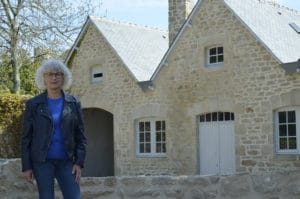" The concept of heritage is a very broad one, especially in relation to the office of mayor. Heritage has different meanings. First of all, there is the built heritage. It is a heritage that embodies a return to the history of where we come from, where we are going. The notion of heritage can thus be extended to the future. This is how I see the cannery. We have inherited this beautiful object from the past in order to accompany it into the future. I hope that this element of our communal heritage will allow us to bounce back economically, touristically, socially, culturally and in many other ways. "Christine Zamuner, Mayor of Loctudy - 2014-2020 and 2020-2026 terms of office
After spending a good part of her life in the world of finance with the State, including several years with the Departmental Directorate of Equipment (DDE), Christine Zamuner has put her skills and determination at the service of the inhabitants of Loctudy as mayor. A former deputy finance minister between 2002 and 2014 under the mandate of Joël Piété, Mrs Zamuner was re-elected with her municipal team in March 2020. She is now devoting herself to carrying out the projects she initiated during her first term (2014-2020). The Alexis Le Gall cannery museum project is one of them. She agreed to tell us more about this project, which was a central part of the project to revitalise the town centre within the election programme.
his background professional
My professional background is mainly financial. I started working in 1976. I first joined the equipment department in Quimper. I held management positions for 25 years. In these various positions, I was in charge of personnel management as well as budgets, which were substantial on the scale of Finistère, at the level of the departmental equipment directorate. Having had three children, I retired in 2001. That same year, I was asked by the former mayor of Loctudy, Joël Piété, to join his municipal list. So I joined the Loctudy town council as a councillor in March 2001. In March 2002, I was appointed deputy for finance. I held this position until 2014, when I ran for the municipal elections to take over from Mr Piété's list. My team was elected for a first mandate, from March 2014 to March 2020. In March of last year, we began our second mandate, which runs until March 2026.
its role in the framework of the museum project
In 2015, Mr Chapalain came to introduce himself to us at the town hall. As the husband of one of Alexis Le Gall's granddaughters, Jean-Philippe Chapalain was, at the time, the owner of the cannery. He was in charge of the conservation and development of this family heritage. I would like to point out that Mr Chapalain always wanted to keep the cannery as it was. He never considered selling it to a property developer. From that meeting in the town hall, I accompanied Mr Chapalain in all his steps, in particular that of classification with the Historic Monuments. I also accompanied my former deputy finance minister, Jean Laouénan, who had taken the matter "head on". Throughout my first term of office, from 2014 to 2020, I encouraged and supported this project to develop the cannery. The cannery gradually became a central part of the project to revitalise the town centre within the electoral programme.
its notion of heritage for the Mayor of Loctudy
The concept of heritage is a very broad one, especially in relation to the office of mayor. Heritage has different meanings. First of all, there is the built heritage. It is a heritage that embodies a return to history, where we come from, where we are going. The cannery is part of this type of heritage, although it is not limited to it. It also represents a cultural heritage, an economic heritage. It is a very good example of this. It embodies a page in the history of Loctudy which had repercussions on the social organisation of the commune, notably through the work of the women, who came to complete the work of the men who had gone to sea. The notion of heritage can also be extended to the future. This is how I see the cannery. We have inherited this beautiful object from the past in order to accompany it into the future. I hope that this element of our communal heritage will allow us to bounce back economically, touristically, socially, culturally, and in many other ways.
its challenges of the project
The first challenge was a human one. When my municipal team was elected in 2014, my colleague Jean Laouénan, who was then deputy for finance and for the economic and tourist development of the commune, became passionate about the Alexis Le Gall cannery project. During his 6-year term of office, from 2014 to 2020, he had to show great tenacity, determination and an ability to overcome both physical and moral challenges. I thank him greatly for having succeeded in meeting all the challenges he has faced. I accompanied him on some of them, but not all. In particular, I would like to pay tribute to the arguments he developed to defend the project.
The second challenge was also human. We had to convince Mr Chapalain to agree to sell us the cannery. Furthermore, when Mr Laouenan left the municipal team in March 2020, we had to find a successor who would be able to continue his work and carry on with the project. The project should not stop. Its continuity had to be ensured. This challenge was successfully met thanks to the arrival of Pierre Quillivic in the municipal team, as 3rd deputy in charge of the cannery works, digital development and mobility of the city. The continuity of the project was also reinforced by the recruitment last winter of a director for the future cannery museum, Johan Verdier-Matayron.
its best souvenir
Undeniably, I chose to open the cannery to the public during the Heritage Days in September 2020, in the presence of Jean Laouénan and Pierre Quillivic, both of whom are driven by the same passion to pass on the history of this heritage to visitors. I remember the starry eyes of the visitors who strolled through the cannery throughout the day.


